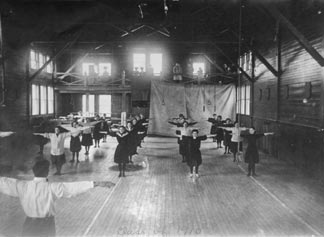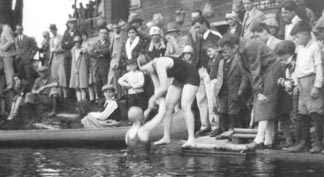“Have Not the Women the Same Rights as the Men?”
Pioneers in Women’s Sports at St. Lawrence
In conjunction with the University’s sesquicentennial, Professor
Emerita of Sport and Leisure Studies Dotty Hall has written
Women’s
Sports at St. Lawrence University: From Beginnings to Title
IX. The
book is available online or in person at Brewer Bookstore.
As she notes in her Foreword, her study commences in 1894 with the establishment
of a women’s basketball club and ends in 1974 when women’s
and men’s athletics were merged into one department and the Education
Amendments Act of 1972 (“Title IX”) demanded a new approach
to women’s athletics. Prof. Hall portrays an 80-year period of growth,
decline and recovery setting the stage for the great expansion
and achievements of the past 30 years.
Origins of First Sports (1894 – 1914)
 About twenty-five of the young ladies of the college have formed a basketball
club. The games are played nearly every afternoon in one of the basement
rooms of College Hall.
About twenty-five of the young ladies of the college have formed a basketball
club. The games are played nearly every afternoon in one of the basement
rooms of College Hall.
--The
Laurentian, December 1894
Basketball, generally recognized as the first sport played by college
women, was also the inaugural women’s sport at St. Lawrence. It even
appears that the women’s basketball club preceded any male basketball
clubs or teams at St. Lawrence.
Class teams seemed to be the
most popular organizing principle for women’s basketball. But
on February 21, 1903, a St. Lawrence “girls’” basketball
team traveled by train to Ogdensburg to play the Ogdensburg
Free Academy girls. The Laurentian, March 1903, reported
that, chaperoned by Professor Mary Young, the SLU girls “led their
opponents until near the close of the second half when the O.F.A. team
tied the score. Time
expired with the score four to four and on playing off the
tie Miss Burt threw the winning goal for O.F.A. Miss Black secured
all of the points for St. Lawrence. Our girls returned with the kindest
reports of their treatment at the hands of their Ogdensburg hosts.”
Tennis was the second sport to be organized by and for
women students. Field hockey began in the second
decade of the 20th century.
Slow and Steady Growth (1915-1931)
 “The old type of woman, who thought it undignified
to take any more violent type of exercise than a stroll about
her flower garden, well protected by a parasol, is surely
becoming extinct. We hope to see such sports as archery,
hockey, etc., already popular at many women’s colleges,
introduced at St. Lawrence in due season.” --The
Hill News, December 5, 1921
“The old type of woman, who thought it undignified
to take any more violent type of exercise than a stroll about
her flower garden, well protected by a parasol, is surely
becoming extinct. We hope to see such sports as archery,
hockey, etc., already popular at many women’s colleges,
introduced at St. Lawrence in due season.” --The
Hill News, December 5, 1921
Well into the
mid-1920s, growth in women’s sports at St. Lawrence
was slow, but steady. Then, in 1924, the women’s varsity
basketball team was disbanded.
|
| Martha Sansom
was St. Lawrence's first director of women's athletics
(1926). |
An exciting new era began in women’s
sport and physical education at St. Lawrence in 1926 with Martha Sansom’s
appointment as women’s
athletic director. Miss Sansom provided effective leadership
for significant growth and development. Existing programs became stronger
and many new activities were added. But they reflected a time when broad-based
participation was captured by the oft-quoted “A girl in every sport
and a sport for every girl.” This cliché was promoted by those
female physical educators who continued to oppose high-level competition
for girls and women in the country’s educational institutions.
Responsive
to the growing “anti-competitive movement” within women’s
intercollegiate sport, the Women’s Athletic Association (WAA) hosted
several non-competitive “play days” over the next few decades. This
concept is best conveyed in a Hill News article of May 8, 1929, about the first
such event for St. Lawrence: “Representatives from Middlebury, Syracuse,
Elmira, Buffalo, and St. Lawrence are expected to be in Canton. Teams
for baseball, basketball, tennis, archery, and track will be selected from
the girls taking part in the meet, quite regardless of their respective schools. The
motive of the ‘play day’ is not to test the athletic skill of any
of the colleges represented, but merely to promote intercollegiate friendliness
among the women of the various student bodies.”
The Anti-Competitive
Era (1932-1967)
|
| Helen Hicks, one
of 13 LPGA founders, came to campus to display her golf
skills, speak at the Women's Athletic Association (WAA)
end-of-the-year rally and conduct a clinic for students
in May 1937. |
“Women’s sports, except perhaps skiing, were not highly valued,
but those of us who persevered enjoyed the experience.” --Susan
Powers Suger ’54
In response to calls for more organized women’s intercollegiate
athletics, it would take several decades for women’s sports at St.
Lawrence to get beyond isolated instances of intercollegiate
competition. In
the intervening years, a variety of sports with varying formats
were introduced at St. Lawrence, some for men as well as women: soccer,
golf, volleyball, badminton and ping-pong.
Intercollegiate athletic
activity was minimal at best throughout World War II. Skiing
became firmly entrenched; established in the late 1930s, the women’s team continued
to travel to various collegiate winter carnival events, winning the UVM
carnival in 1948. Although it did not yet include competition against other
schools, the WAA-sponsored Spring Riding Show was considered a major campus
activity.
A Fencing Club,
open to women and men, was established in 1948. The
club sponsored men’s and women’s teams drawn from its membership. Fencers
including Dot Norton ’53, Hedevig “Deddy” Frolich ’52,
Thelma Gore ’51, Nathalie Norton ’53 and Nancy Des Reis ’54
were part of a four-year winning streak, 1950-54.
For almost 20 years,
from the end of World War II into the mid-1960s, a “typical WAA year” reflected
what was happening at St. Lawrence as the anti-competitive era in women’s
sports slowly drew to a close. In addition to the fall, winter and
spring “play
days,” annual events included a fall mountain climbing trip in the
Adirondacks, followed by a Halloween party. “The WAA on Ice” was
the main winter event; the annual horse show was featured in the spring.
Changing Programs and the Impact of Title IX (1968-1974)
“No person shall…. on the basis of sex, be excluded from
participation
in, be denied the benefits of, or be subjected to discrimination
under any educational programs or activities receiving federal
financial assistance.”
Title
IX – Education Act of 1972
In her article “Women’s Pre-Title
IX Sports History in the United States,” Nancy Struna states that
there was “a dynamic
and continuing growth of women’s sports in the late 1960’s” (www.womenssportsfoundation.org). St.
Lawrence’s women were not left behind in this movement.
Throughout the 1960s, Women’s Athletic and Recreation Association
(WARA, the successor to the WAA) sports days became less frequent
and department-sponsored teams were organized. By the close of the
decade, limited game schedules for intercollegiate competition
began to grow for field hockey, tennis and basketball.
In the
fall of 1974, the merging of the men’s and women’s departments
paved the way for a committed effort to adhere to both the spirit and the
letter of Title IX. Women’s intercollegiate offerings continued
to grow, with soccer, ice hockey, volleyball, swimming, cross country and
track and field. Later, softball was elevated from club status. When
crew, golf and squash were added in the late 1990s for both women and men,
the college reached its current level of offerings – 15 for men,
16 for women and one, riding, which is coeducational in the modern meaning
of the word.

